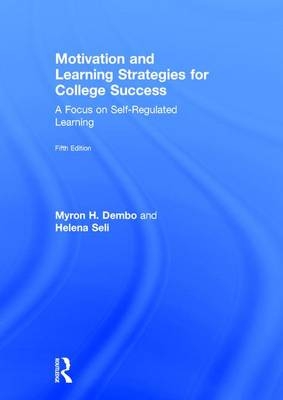
Motivation and Learning Strategies for College Success
Routledge (Verlag)
978-1-138-85033-0 (ISBN)
- Titel erscheint in neuer Auflage
- Artikel merken
New in the Fifth Edition
Discussion of the importance of sleep in learning and memory
Revised and updated chapter on self-regulation of emotions
Current research on impact of students’ use of technology including digital learning platforms and tools, social media, and online learning
Updated Companion Website resources for students and instructors
Myron H. Dembo is Emeritus Professor of Educational Psychology in the Rossier School of Education at the University of Southern California, USA. Helena Seli is Associate Professor of Clinical Education in the Rossier School of Education at the University of Southern California, USA.
Contents
Preface Acknowledgments Figure and Table Credits
UNIT I: FOUNDATIONS OF LEARNING AND MOTIVATION
Chapter 1 Academic Self-Regulation
What Is Academic Self-Regulation?
What Is the Difference Between High School and College?
Why Are Some Students Less Successful Learners?
They Hold Faulty Beliefs about Their Ability, Learning, and Motivation
They Are Unaware of Their Ineffective Learning Behavior
They Fail to Sustain Effective Learning and Motivational Strategies
They Are Not Ready to Change Their Learning and Study Behavior
How Can I Manage My Academic Behavior?
Motivation
Methods of Learning
Use of Time
Physical and Social Environment
Monitoring Performance
The Six Components of Academic Self-Regulation
Exercise 1.1: Self-Observation: Assessing Your Self-Regulatory Skills
How Can I Change My Behavior?
How Does Self-Regulation Occur in an Academic Context?
Key Points
Follow-Up Activities
Chapter 2 Understanding Motivation
Motivational Problems
What Is Motivation and What Factors Influence It?
Motivated Behaviors
Sociocultural Factors
Classroom Environmental Factors
Exercise 2.1: Self-Observation: Analyzing My Personal and Sociocultural Background
Exercise 2.2: Self-Observation: Analyzing Classroom Experiences
Internal Factors
Exercise 2.3: Possible Selves: My Hopes, Expectations, and Fears
about the Future
Exercise 2.4: Identifying Mastery and Performance Goal
Orientations
Am I Motivated to Change My Academic Behavior?
I Can’t Change
I Don’t Want to Change
I Don’t Know What to Change
I Don’t Know How to Change
Key Points
Follow-Up Activities
Chapter 3 Understanding Learning and Memory
Where Does Learning Take Place in the Brain?
Is Intelligence Fixed or Malleable?
Why Is a Growth Mindset More Beneficial than a Fixed Mindset?
Exercise 3.1: Self-Observation: Analyzing My Mindset
How Does the Information-Processing System Explain Learning?
Short-Term Sensory Store
Working Memory
Exercise 3.2: Demonstrating the Capacity of Working Memory
Long-Term Memory
What Are the Flaws in Human Memory?
What Is the Difference between Rote and Meaningful Learning?
Which Learning Strategies Promote Learning and Retention?
Rehearsal Strategies
Elaboration Strategies
Organizational Strategies
Exercise 3.3: Demonstrating the Importance of Categorizing Knowledge
Exercise 3.4: Identifying Learning Strategies
Key Points
Follow-Up Activities
UNIT II: MOTIVATIONAL STRATEGIES
Chapter 4 Goal Setting
Exercise 4.1: Self-Observation: Identifying Your Values
Why Is Goal Setting Important?
What Properties of Goals Enhance Motivation?
What Are the Steps in the Goal-Setting Process?
Step 1: Identifying and Defining the Goal
Exercise 4.2: Writing Personal Goals
Step 2: Generating and Evaluating Alternative Plans
Step 3: Making Implementation Plans
Step 4: Implementing the Plan
Step 5: Evaluating Your Progress
Key Points
Follow-Up Activities
Chapter 5 Self-Regulation of Emotions
Exercise 5.1: Self-Observation: Assessing Emotions
What Do We Know about College Students’ Mental Health?
What Types of Solutions Are Available for Emotional and Mental Health Issues?
What Causes our Emotions?
How Does Self-talk Affect My Emotions and Behavior?
Exercise 5.2: Identify Irrational Thinking Patterns
What Do We Know about Stress and Anxiety Among College Students?
What Are Some Self-Regulatory Solutions for Stress and Anxiety?
What Do We Know About Depression Among College Students?
What Are Some Self-Regulatory Strategies to Address Depression?
What is the Impact of Boredom on Academic Performance?
What Are Self-Regulatory Strategies to Address Boredom?
Key Points
Follow-Up Activities
UNIT III: BEHAVIORAL STRATEGIES
Chapter 6 Time Management
What Is Time Management?
How Do You Use Your Time?
Exercise 6.1: Self-Observation: Assessing Time Wasters
Exercise 6.2: Self-Observation: Assessing Use of Time
What Are Some Good Time-Management Strategies?
Set Regular Study Periods
Create an Environment that Is Relatively Free of Distractions and Interruptions
Schedule Tasks So They Can Be Accomplished in 30- to 60-Minute Blocks of Time
Take Short Breaks
Be Specific in Identifying How You Plan to Use Your Time
Alternate Subjects When You Have a Long Time Block Available
for Study
Estimate the Time Needed for Each Assignment
Prioritize Tasks
Do the Assignments for the Course You Dislike First
Work Ahead of Your Assignments When Possible
Take Down Any Appointments as Soon as You Make Them in Your Smartphone or Calendar
Use Technology to Manage Your Time
How Do I Develop a System of Time Planning and Management?
Semester Calendar
Weekly Priority Tasks List
Weekly Schedule
What Is Procrastination?
Procrastination and the Internet
What Are the Causes of Procrastination?
What Can I Do about My Tendency to Procrastinate?
Procrastination Elimination Strategies
Challenging and Changing Beliefs and Misperceptions
Exercise 6.3: Challenge Irrational Beliefs
Key Points
Follow-Up Activities
Chapter 7 Self-Regulation of the Physical and Social Environment
What are the Costs of Multitasking?
Is There a Difference between Attention and Concentration?
Exercise 7.1: Self-Observation: Evaluating Study Environments
What Factors Influence Attention and Concentration?
Exercise 7.2: Self-Observation: Becoming Aware of Misdirected Attention
Exercise 7.3: Self-Observation: Becoming Aware of Your Listening Habits
How Can I Improve My Attention and Concentration?
Exercise 7.4: Dealing with Distracters
How Do I Seek Academic Help?
Do Students Have Different Motives for Communicating with Their Instructors?
How Can I Work More Effectively in Groups?
How Can I Help Make My Study Group More Productive?
How Can I Improve My Communication Skills?
Sending Messages Effectively
Receiving Messages Effectively
Key Points
Follow-Up Activities
UNIT IV: LEARNING AND STUDY STRATEGIES
Chapter 8 Learning from Textbooks
What Does Research Tell Us about Skillful Readers?
Exercise 8.1: Self-Observation: Assessing Reading Strategies
What Learning Strategies Can I Use to Improve My Reading Comprehension and Retention?
Before Reading
Exercise 8.2: Understanding the Importance of Prior Knowledge
During Reading
After Reading
How Can I Construct Representations?
Exercise 8.3: Representations in Academic Content
Exercise 8.4: Constructing Different Representations for the
Material
Key Points
Follow-Up Activities
Chapter 9 Learning from Class
Exercise 9.1: Self-Observation: Analyzing Note-Taking Strategies
How Can I Take Better Class Notes?
Before Class
During Class
After Class
Exercise 9.2: Practicing the Note-Taking Strategy
How Can I Ask Good Mirror Questions?
Exercise 9.3: Identifying the Different Levels of Questions in Class
How Do I Deal with Particular Note-Taking Problems or Issues?
Key Points
Follow-Up Activities
Chapter 10 Preparing for Exams
Exercise 10.1: Self-Observation: Assessing Exam Preparation
How Do I Develop a Study Plan?
Step 1: Determine the Content Coverage and Question Format of
the Exam
Step 2: Organize and Separate the Content into Parts
Step 3: Identify Specific Study Strategies
Step 4: Identify the Amount of Time Needed for Each Strategy
Step 5: Allocate Time for Each Study Strategy in a Weekly Schedule
Step 6: Modify the Plan as Necessary
An Example of a Study Plan
Content Coverage and Question Format
Organize the Content for Study
Identify Specific Study Strategies
Identify the Amount of Time Needed for Each Strategy
Allocate Time for Each Study Strategy in a Monthly or Weekly Schedule
Key Points
Follow-Up Activities
Chapter 11 Taking Exams
Exercise 11.1: Self-Observation: Assessing Test-Taking Strategies
What Strategies Can I Use to Answer Objective Test Questions?
How Should You Manage Your Time?
How Should You Approach Each Question?
When Should You Change an Answer?
Strategies for True–False Questions
Exercise 11.2: Identifying Key Words
Strategies for Matching Questions
Strategies for Fill-in-the-Blank Questions
Strategies for Multiple-Choice Questions
Exercise 11.3: Taking a Multiple-Choice Exam
What Strategies Can I Use for Answering Essay Writing Prompts?
Read the Directions Carefully and Do Exactly What Is Asked
Read Each Prompt Carefully to Determine What Is Expected in
the Response
Determine How You Will Use Your Time
Determine the Order in Which You Will Respond to the Prompts
Organize Your Response by Making an Outline or Representation (Map)
Write Your Answer Following Specific Procedures
If Given an Opportunity, Review Your Exam Results
Evaluating the Two Essay Responses
Exercise 11.4: Evaluating Responses to an Essay Prompt
Key Points
Follow-Up Activities
Afterword
Motivation
Methods of Learning/Monitoring of Performance
Use of Time
Physical and Social Environment
Glossary
Appendices
Appendix A: A Guide for Completing a Self-Regulation Study
Appendix B: Examples of Self-Regulation Studies
Notes
References
Author Index
Subject Index
| Erscheinungsdatum | 08.02.2017 |
|---|---|
| Zusatzinfo | 22 Line drawings, black and white; 50 Tables, black and white; 22 Illustrations, black and white |
| Verlagsort | London |
| Sprache | englisch |
| Maße | 178 x 254 mm |
| Gewicht | 839 g |
| Themenwelt | Geisteswissenschaften ► Psychologie ► Pädagogische Psychologie |
| Sozialwissenschaften ► Pädagogik | |
| ISBN-10 | 1-138-85033-0 / 1138850330 |
| ISBN-13 | 978-1-138-85033-0 / 9781138850330 |
| Zustand | Neuware |
| Haben Sie eine Frage zum Produkt? |
aus dem Bereich



